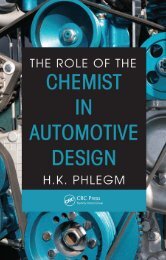Lightweight Electric/Hybrid Vehicle Design
Lightweight Electric/Hybrid Vehicle Design
Lightweight Electric/Hybrid Vehicle Design
Create successful ePaper yourself
Turn your PDF publications into a flip-book with our unique Google optimized e-Paper software.
Introduction xxi<br />
gains made in the decade 1985–1995 were lost by making engines powerful enough, in the US, to<br />
drive at twice the speed limit on the open road. Obviously the situation is worsened if conventional<br />
heavyweight steel construction is used and the tare weight of cars rises with the increasing<br />
proliferation of on-board gadgetry. While ‘supercar’ construction has shown how structure weight<br />
can be reduced, advanced technology could also be used to reduce the 10% of engine power used<br />
in powering ‘accessories’ such as power steering, heating, lighting and in-car entertainment.<br />
The imperative for power steering is removed by the ultra-light construction of the ‘supercar’,<br />
provided steering and handling dynamics are properly designed. In EV supercars, wheel motors<br />
might provide for ABS and ASR without further weight penalty. High intensity headlamp<br />
technology can considerable reduce power demand as can the use of fibre-optic systems which<br />
provide multiple illumination from a single light source. Light-emitting diode marker lamps can<br />
also save energy and experts believe that the energy consumption of air-conditioning systems<br />
could be reduced by 90%, if properly designed, and used in cars with sandwich panel roofs, heatreflecting<br />
windows and solar-powered ventilation fans. But none of this compares with the savings<br />
made by high strength composite construction which has the potential to bring down average car<br />
weight from 3000 to 1000 lb. It is reported that many of the 2000 or so lightweight EVs operating<br />
in Switzerland already weigh only 575 lb without batteries.<br />
The ability to achieve net shape and finish colour from the mould in polymer composite<br />
construction is important in offsetting the higher cost of high strength composites over steel. But<br />
also the cost of steel is only 15% of the conventional structure cost, the remainder being taken up<br />
in forming, fabrication and finishing. Around half the cost is taken up by painting. The cheaper<br />
tooling required for polymer composites is also important in making small-scale production a<br />
feasible proposition, alongside direct sales from the factory of ‘made-to-order’ cars. A number of<br />
these factors would help to remove the high mark-up to the customer of the factory price which is<br />
typical of conventional car sales and distribution.<br />
0.3 Lean production, enterprise structures and networking<br />
Lean production has grown out of post-Fordist ‘flexible specialization’ which has led to growing<br />
specialization of products, with a new emphasis on style and/or quality. The differentiated products<br />
require shorter production runs and more flexible production units, according to Clarke 2 . The<br />
flexibility is made possible by new technologies, the emerging economic structure being based on<br />
computerization and other microchip hardware. Rapid gains in productivity are made through full<br />
automation and computerized stock control within a system that allows more efficient small batch<br />
production. Automatic machine tools can be reprogrammed very quickly to produce small quantities<br />
of much more specialized products for particular market niches. Economies are set to be no longer<br />
dominated by competition between hierarchically organized corporations and open to those<br />
dominated by cooperation between networks of small and interrelated companies.<br />
Lean enterprises are seen as groups of individuals, functions, and legally separate but operationally<br />
synchronized companies that create, sell, and service a family of products, according to Womack<br />
et al 3 . This is similar to the Japanese ‘keiretsu’ concept of large, loose groupings of companies with<br />
shareholding connections. They cooperate both technically and in sharing market information and<br />
the result is an array of business units competing in vertically and horizontally links with other<br />
companies within a single project. A trading company with well-developed worldwide networks is<br />
usually at the centre of the operation and can feed back vital market trends to the production companies.<br />
Of almost equal importance is the involvement of international banking corporations who can provide<br />
a source of industrial finance. Changes in legislation are required by European countries to make a<br />
similar system of common shareholdings plus private ownership acceptable to company law.







